Current Research Status and Future Trends of Vibration Energy Harvesters
Abstract
:1. Introduction
2. Electromagnetic Vibration Energy Harvester
2.1. Working Principle and Characteristics of the Electromagnetic Vibration Energy Harvester
2.2. Advances in Electromagnetic Vibration Energy Harvesters
3. Piezoelectric Vibration Energy Harvester
3.1. Operating Principle and Characteristics of Piezoelectric Vibration Energy Harvester
3.2. Progress of Research on Piezoelectric Vibration Energy Harvesters
4. Friction Electric Vibration Energy Harvester
4.1. Mechanism of Operation and Characteristics of the Friction Electric Vibration Energy Harvesters
4.1.1. Friction Nanogenerator
4.1.2. Principle of Friction Electric Vibration Energy Harvester
4.2. Advances in Friction Electric Vibration Energy Harvesters
5. Electrostatic Vibration Energy Harvester
5.1. The Working Principle of the Electrostatic Vibration Energy Harvester and Its Characteristics
5.2. Current Research Status of Electrostatic Vibration Energy Harvesters
6. Magnetostrictive Vibration Energy Harvester
6.1. Operating Principle and Characteristics of Magnetostrictive Vibration Energy Harvesters
6.2. Current Status of Research on Magnetostrictive Vibration Energy Harvesters
7. Conclusions
- (1)
- The electromagnetic vibration energy collector has the virtues of collecting vibration energy with wide bandwidth, large output current, and high output power, but it has the shortcomings of low output voltage, magnetic leakage, and large size.
- (2)
- Piezoelectric vibration energy harvesters have the virtues of simple structure and high energy density, but the piezoelectric material, which is the core component of their composition, suffers from low strength, charging leakage, and easy aging.
- (3)
- Friction electric vibration energy harvesters have the advantages of higher output voltage, simplicity of manufacture, durability, and machinability, but have the drawbacks of low output current and low efficiency in harvesting energy.
- (4)
- Electrostatic vibration energy harvesters have advantages in terms of low-frequency power generation and integration capability, but the need for an additional start-up power supply becomes their fatal flaw, in addition to the disadvantages of low current and high output impedance.
- (5)
- Magnetostrictive vibration energy harvesters have the advantages of high energy density and superior magneto-mechanical coupling coefficients, fast response time, and wide operating frequency, but they also suffer from the shortcomings of large size and high price.
- (1)
- Improve reliability and durability: Optimise the material design of the vibration energy harvester. Piezoelectric, magnetostrictive, and magnetoelectric materials, as the key core components of the vibration energy harvester, are directly related to the strength and service life of the harvester, and the service life of the harvester can be increased and the damage rate can be reduced by designing new materials or by improving the strength and durability of these materials.
- (2)
- Optimise the circuit design: the energy collector includes two parts, energy collection and energy conversion, but in the energy conversion part of the circuit, the energy will be lost, and the way in which to effectively use this part of the energy is a major problem to be faced in the future. Combining with intelligent control technology can be used to achieve intelligent management of the vibration energy collector and optimise the control, to increase the efficiency of energy use, and to reduce the waste of energy.
- (3)
- Design of a composite energy harvester: Most of the existing vibration energy harvesters are in single form, and they seldom combine multiple energy harvesting methods; most of the energy harvesters can only collect energy in a single direction, but the energy in the environment comes from all directions. Research into multi-form, multi-directional vibratory energy collectors can vastly increase the accuracy of power harvesting and can power much more powerful electronic devices. In addition, in order to address the disadvantage of the need for an outside start-up energy source for the electrostatic vibration energy harvester, it is possible to combine the electrostatic type with the piezoelectric and magnetostrictive vibration energy harvesters, thus eliminating the need for an external power supply.
- (4)
- Miniaturise and integrate energy harvesters: current vibrational energy harvesters have large dimensions, making integration difficult. Combined with MEMS technology, smaller-size vibration energy harvesters are designed, which is conducive to the integration of microelectromechanical systems.
- (5)
- Utilisation across multiple purposes and ranges: In addition to mechanical vibration, various movements of the human body produce vibrational energy, such as the heartbeat, pulse beat, and human body walking. The development of vibration energy collectors suitable for different environments and vibration frequencies will enable them to be used in more application scenarios, and in this way, more miniature wearable or portable electronic devices can be derived.
Author Contributions
Funding
Institutional Review Board Statement
Informed Consent Statement
Data Availability Statement
Conflicts of Interest
References
- Bouhedma, S.; Bin Taufik, J.; Lange, F.; Ouali, M.; Seitz, H.; Hohlfeld, D. Different Scenarios of Autonomous Operation of an Environmental Sensor Node Using a Piezoelectric-Vibration-Based Energy Harvester. Sensors 2024, 24, 1338. [Google Scholar] [CrossRef] [PubMed]
- Wang, X.; Yin, G.; Sun, T.; Xu, X.; Rasool, G.; Abbas, K. Mechanical Vibration Energy Harvesting and Vibration Monitoring Based on Triboelectric Nanogenerators. Energy Technol. 2024, 12, 2300931. [Google Scholar] [CrossRef]
- Yue, O.; Wang, X.; Xie, L.; Bai, Z.; Zou, X.; Liu, X. Biomimetic Exogenous “Tissue Batteries” as Artificial Power Sources for Implantable Bioelectronic Devices Manufacturing. Adv. Sci. 2024, 11, e2307369. [Google Scholar] [CrossRef]
- Zhang, Y.; Wang, Z.J.; Jiang, S.L.; Wang, Q. Retrospectives and Perspectives of Vibration Energy Harvest Technologies. Mech. Sci. Technol. 2019, 38, 985–1018. [Google Scholar] [CrossRef]
- Ke, Z.; Deng, Z.; Ren, T.; Liu, X.; Yi, H.; Liu, Z.; Li, H.; Sun, Y. Simultaneous vibration suppression and energy harvesting system design via electromagnetic shunt damper for high temperature superconducting pinning maglev. Mech. Syst. Signal Process 2024, 214, 111374. [Google Scholar] [CrossRef]
- Zhao, L.; Zhang, H.; Liu, D.; Zou, Y.; Li, Z.; Liu, B. Application of nanogenerators in self-powered microfluidic systems. Nano Energy 2024, 123, 109432. [Google Scholar] [CrossRef]
- Christenson, G.N.; Yu, Z.; Frontiera, R.R. Wavelength Dependence of Plasmon-Induced Vibrational Energy Transfer in Fluorophore–Plasmonic Systems. J. Phys. Chem. 2024, 128, 10784–10789. [Google Scholar] [CrossRef]
- Qi, Y.; Zhao, J.; Zhang, C. Review and Prospect of Micro-nano Vibration Energy Harvesters. J. Mech. Eng. 2020, 56, 1–15. [Google Scholar]
- Huo, S.; Wang, P.; Long, H.; Ren, Z.; Yi, Q.; Dai, J.; An, B.; Wang, P.; Wang, Y.; Gao, M.; et al. Dual-mode electromagnetic energy harvester by Halbach arrays. Energy Convers. Manag. 2023, 286, 117038. [Google Scholar] [CrossRef]
- Liu, C.; Meng, A.; Chen, W.; Li, H.; Song, H. Research status and development trend of vibration energy harvesting technology. Equip. Manuf. Technol. 2013, 12, 43–47. [Google Scholar]
- Qi, L.; Song, J.; Wang, Y.; Yi, M.; Zhang, Z.; Yan, J. Mechanical motion rectification-based electromagnetic vibration energy harvesting technology: A review. Energy 2024, 289, 130030. [Google Scholar] [CrossRef]
- Hadas, Z.; Vetiska, V.; Vetiska, J.; Krejsa, J. Analysis and efficiency measurement of electromagnetic vibration energy harvesting system. Microsyst. Technol. 2016, 22, 1767–1779. [Google Scholar] [CrossRef]
- Choi, W.K.; Kim, H.J.; Park, C.W.; Lee, B. Study on Electromagnetic Energy Transducer in Ambient Vibration. IET Power Electron. 2018, 11, 1983–1990. [Google Scholar] [CrossRef]
- Wang, Y.; Gao, Y.; Chen, Z.; Zong, R.; Li, Y.; Guo, R.; Azam, A.; Qi, L.; Zhang, Z. Performance analysis of electromagnetic vibration energy harvester under square excitation. Int. J. Mech. Sci. 2024, 271, 109127. [Google Scholar] [CrossRef]
- Peng, Y.; Zhang, L.; Li, Z.; Zhong, S.; Liu, Y.; Xie, S.; Luo, J. Influences of Wire Diameters on Output Power in Electromagnetic Energy Harvester. Int. J. Precis. Eng. Manuf. Green Technol. 2022, 10, 205–216. [Google Scholar] [CrossRef]
- Lo Monaco, M.; Russo, C.; Somà, A. Identification Procedure for Design Optimization of Gravitational Electromagnetic Energy Harvesters. Appl. Sci. 2023, 13, 2736. [Google Scholar] [CrossRef]
- Sun, H.; Peng, H.; Xiao, H.; Liu, X.; Chen, Y.; Gao, K.; Wang, S.; Xu, P. An Optimized Design of Compact Self-Powered Module Based on Electromagnetic Vibration Energy Harvester Considering Engineering Feasibility. IEEE Trans. Ind. Appl. 2023, 59, 767–778. [Google Scholar] [CrossRef]
- Ghouli, Z.; Hamdi, M.; Belhaq, M. Energy harvesting from quasi-periodic vibrations using electromagnetic coupling with delay. Nonlinear Dyn. 2017, 89, 1625–1636. [Google Scholar] [CrossRef]
- Nicolini, L.; Castagnetti, D.; Sorrentino, A. A tunable multi-arm electromagnetic pendulum for ultra-low frequency vibration energy harvesting. Smart Mater. Struct. 2022, 31, 115009. [Google Scholar] [CrossRef]
- Xiong, L.; Gao, S.; Jin, L.; Sun, Y.; Du, X.; Liu, F. Study on the Influence of Coil Arrangement on the Output Characteristics of Electromagnetic Galloping Energy Harvester. Micromachines 2023, 14, 2158. [Google Scholar] [CrossRef]
- Sun, R.; Zhou, S.; Li, Z.; Cheng, L. Dual electromagnetic mechanisms with internal resonance for ultra-low frequency vibration energy harvesting. Appl. Energy 2024, 369, 123528. [Google Scholar] [CrossRef]
- Kumar, A.; Kiran, R.; Chauhan, V.S.; Kumar, R.; Vaish, R. Piezoelectric energy harvester for pacemaker application: A comparative study. Mater. Res. Express 2018, 5, 075701. [Google Scholar] [CrossRef]
- Zhang, Y. Sandwich Piezoelectric Transducer and Its Applications; Science Press: Beijing, China, 2006. [Google Scholar]
- Zhang, Y. Key Technology Study of Mass-Sharing Cantilever Array Based Micro Piezoelectric Vibration Energy Harvester. Master’s Thesis, Chongqing University, Chongqing, China, 2016. [Google Scholar]
- Galassi, C.; Roncari, E.; Capiani, C.; Craciun, F. Processing and characterization of high Qm ferroelectric ceramics. J. Eur. Ceram. Soc. 1999, 19, 1237–1241. [Google Scholar] [CrossRef]
- Fang, H.-B.; Liu, J.Q.; Xu, Z.Y.; Dong, L.; Wang, L.; Chen, D.; Cai, B.C.; Liu, Y. Fabrication and performance of MEMS-based piezoelectric power generator for vibration energy harvesting. Microelectron. J. 2006, 37, 1280–1284. [Google Scholar] [CrossRef]
- Shen, D.; Park, J.H.; Ajitsaria, J.; Choe, S.Y.; Wikle, H.C.; Kim, D.J. The design, fabrication and evaluation of a MEMS PZT cantilever with an integrated Si proof mass for vibration energy harvesting. J. Micromech. Microeng. 2008, 18, 055017. [Google Scholar] [CrossRef]
- Ye, J.; Ding, G.; Wu, X.; Zhou, M.; Wang, J.; Chen, Y.; Yu, Y. Development and performance research of PSN-PZT piezoelectric ceramics based on road vibration energy harvesting technology. Mater. Today Commun. 2023, 34, 105135. [Google Scholar] [CrossRef]
- Xiang, Z.Y.; Zhang, J.K.; Li, S.J.; Xie, S.L.; Liu, F.P.; Zhu, R.D.; He, D.K. Friction-induced vibration energy harvesting via a piezoelectric cantilever vibration energy collector. Tribol. Int. 2023, 189, 108933. [Google Scholar] [CrossRef]
- Zhang, Y.; Zhang, G.; Wang, W. A piezoelectric cantilever-beam-spring-pendulum oscillator for multi-directional vibration energy harvesting. Commun. Nonlinear Sci. Numer. Simul. 2024, 138, 108199. [Google Scholar] [CrossRef]
- Wang, J.; Han, C.; Jo, S.-H.; Xu, W.; Tian, H. Enhanced flow induced vibration piezoelectric energy harvesting performance by optimizing tapered beam. Ocean Eng. 2024, 300, 117459. [Google Scholar] [CrossRef]
- Man, D.; Jiang, B.; Xu, Q.; Tang, L.; Zhang, Y.; Xu, G.; Han, T. Enhancing low-orbit vibration energy harvesting by a tri-stable piezoelectric energy harvester with an innovative dynamic amplifier. AIP Adv. 2024, 14, 045210. [Google Scholar] [CrossRef]
- Cho, K.-H.; Park, H.-Y.; Heo, J.S.; Priya, S. Structure—Performance relationships for cantilever-type piezoelectric energy harvesters. J. Appl. Phys. 2014, 115, 204108. [Google Scholar] [CrossRef]
- Lee, B.S.; Lin, S.C.; Wu, W.J.; Wang, X.Y.; Chang, P.Z.; Lee, C.K. Piezoelectric MEMS generators fabricated with an aerosol deposition PZT thin film. J. Micromech. Microeng. 2009, 19, 065014. [Google Scholar] [CrossRef]
- Nair, R.; Tripathi, B.; Jain, A.; Shehata, N. Vibrational energy harvesting and tactile sensing applications based on PVDF-TPU piezoelectric nanofibers. J. Mater. Sci. Mater. Electron. 2024, 35, 857. [Google Scholar] [CrossRef]
- Ramírez, J.M.; Gatti, C.D.; Machado, S.P.; Febbo, M. A multi-modal energy harvesting device for low-frequency vibrations. Extrem. Mech. Lett. 2018, 22, 1–7. [Google Scholar] [CrossRef]
- Su, Y. The Study of Design Preparation and Applications of Triboelectric Nanogenerators. Ph.D. Thesis, University of Electronic Science and Technology, Chengdu, China, 2016. [Google Scholar]
- Du, X.; Zhang, K. Recent progress in fibrous high-entropy energy harvesting devices for wearable applications. Nano Energy 2022, 101, 107600. [Google Scholar] [CrossRef]
- Haroun, A.; Tarek, M.; Mosleh, M.; Ismail, F. Recent Progress on Triboelectric Nanogenerators for Vibration Energy Harvesting and Vibration Sensing. Nanomaterials 2022, 12, 2960. [Google Scholar] [CrossRef] [PubMed]
- Wang, Z.L.; Wang, A.C. On the origin of contact-electrification. Mater. Today 2019, 30, 34–51. [Google Scholar] [CrossRef]
- Yang, W.; Chen, J.; Jing, Q.; Yang, J.; Wen, X.; Su, Y.; Zhu, G.; Bai, P.; Wang, Z.L. 3D Stack Integrated Triboelectric Nanogenerator for Harvesting Vibration Energy. Adv. Funct. Mater. 2014, 24, 4090–4096. [Google Scholar] [CrossRef]
- Qiu, W.; Feng, Y.; Luo, N.; Chen, S.; Wang, D. Sandwich-like sound-driven triboelectric nanogenerator for energy harvesting and electrochromic based on Cu foam. Nano Energy 2020, 70, 104543. [Google Scholar] [CrossRef]
- Shi, Q.; Yang, J.; Gui, H.; Gui, Y.; Tang, C.; Yu, Y.; Zhao, Z. Self-powered circular-honeycomb triboelectric nanogenerator for vibration energy harvesting and resonance detection of synchronous machine. Sens. Actuators Phys. 2023, 354, 114291. [Google Scholar] [CrossRef]
- Liu, Z.; Zhao, C.; Hu, G.; Yang, Y. A multi-degree-of-freedom triboelectric energy harvester for dual-frequency vibration energy harvesting. Mech. Syst. Signal Process. 2023, 188, 109951. [Google Scholar] [CrossRef]
- Yang, X.; Zheng, H.; Ren, H.; An, G.; Zhang, Y.; Yang, W. A tuned triboelectric nanogenerator using a magnetic liquid for low-frequency vibration energy harvesting. Nanoscale 2024, 16, 1915–1923. [Google Scholar] [CrossRef]
- Gao, S.; Wei, H.; Wang, J.; Luo, X.; Wang, R.; Chen, Y.; Xiang, M.; Chen, X.; Xie, H.; Feng, S. Self-powered system by a suspension structure-based triboelectric-electromagnetic-piezoelectric hybrid generator for unifying wind energy and vibration harvesting with vibration attenuation function. Nano Energy 2024, 122, 109323. [Google Scholar] [CrossRef]
- Zhao, H.; Ouyang, H. Theoretical investigation and experiment of a disc-shaped triboelectric energy harvester with a magnetic bistable mechanism. Smart Mater. Struct. 2021, 30, 095026. [Google Scholar] [CrossRef]
- Naruse, Y.; Matsubara, N.; Mabuchi, K.; Izumi, M.; Suzuki, S. Electrostatic micro power generation from low-frequency vibration such as human motion. J. Micromech. Microeng. 2009, 19, 094002. [Google Scholar] [CrossRef]
- Bu, L.; Wu, X.; Wang, X.; Liu, L. A Novel Vibration Energy Harvester of Polytetrafluoroethylene Bulk Electrets and Double Side Charging Structure. Nanotechnol. Precis. Eng. 2013, 11, 497–502. [Google Scholar]
- Kloub, H.; Hoffmann, D.; Folkmer, B.; Manoli, Y. A micro capacitive vibration energy harvester for low power electronics. Work 2009, 11, 1. [Google Scholar]
- Tao, K.; Wu, J.; Tang, L.; Hu, L.; Lye, S.W.; Miao, J. Enhanced electrostatic vibrational energy harvesting using integrated opposite-charged electrets. J. Micromech. Microeng. 2017, 27, 044002. [Google Scholar] [CrossRef]
- Aliasghary, M.; Azizi, S.; Madinei, H.; Haddad Khodaparast, H. On the Efficiency Enhancement of an Actively Tunable MEMS Energy Harvesting Device. Vibration 2022, 5, 603–612. [Google Scholar] [CrossRef]
- Erturun, U.; Eisape, A.; West, J.E. Design and analysis of a vibration energy harvester using push-pull electrostatic conversion. Smart Mater. Struct. 2020, 29, 105018. [Google Scholar] [CrossRef]
- Yamane, D.; Tamura, K.; Nota, K.; Iwakawa, R.; Lo, C.Y.; Miwa, K.; Ono, S. Contactless Electrostatic Vibration Energy Harvesting Using Electric Double Layer Electrets. Sens. Mater. 2022, 34, 1869–1877. [Google Scholar] [CrossRef]
- Deng, Z.; Dapino, M.J. Review of magnetostrictive vibration energy harvesters. Smart Mater. Struct. 2017, 26, 103001. [Google Scholar] [CrossRef]
- Dai, X.-Z.; Wen, Y.-M.; Li, P.; Yang, J.; Jiang, X.-F. Vibration energy harvester based on magnetoelectric transducer. Acta Phys. Sin. 2010, 59, 2137–2146. [Google Scholar] [CrossRef]
- Cao, S.; Sun, S.; Zheng, J.; Wang, X.; Han, J.; Liu, L. Research Progress of Magnetostrictive Vibration Energy Harvesters. Micro Nano Electron. 2017, 54, 612–620. [Google Scholar] [CrossRef]
- Kita, S.; Ueno, T.; Yamada, S. Improvement of force factor of magnetostrictive vibration power generator for high efficiency. J. Appl. Phys. 2015, 117, 17B508. [Google Scholar] [CrossRef]
- Yan, B.; Zhang, C.; Li, L. Design and Fabrication of a High-Efficiency Magnetostrictive Energy Harvester for High-Impact Vibration Systems. IEEE Trans. Magn. 2015, 51, 1–4. [Google Scholar] [CrossRef]
- Dong, W.; Liang, Q.; Liu, H.; Mei, X.; Shu, L.; Liu, Z.; Chang, Y. Characterization of magnetostrictive bi-stable rotational vibration energy harvester with integrated centrifugal effect. Smart Mater. Struct. 2024, 33, 025034. [Google Scholar] [CrossRef]
- Liu, H.; Tong, X.; Sun, X.; Wang, W.; Su, L.; Chang, Y.; Liu, Z. Design and analysis of magnetostrictive two-dimensional kinetic energy harvester. Smart Mater. Struct. 2024, 33, 025032. [Google Scholar] [CrossRef]
- Liu, Z.; Huang, W.; Guo, P.; Yang, H.; Weng, L.; Wang, B. Nonlinear Model for Magnetostrictive Vibration Energy Harvester Considering Dynamic Forces. IEEE Sens. J. 2024, 24, 16270–16278. [Google Scholar] [CrossRef]
- Liu, H.; Liu, H.; Zhao, X.; Li, A.; Yu, X. Design and Characteristic Analysis of Magnetostrictive Vibration Harvester with Double-Stage Rhombus Amplification Mechanism. Machines 2022, 10, 848. [Google Scholar] [CrossRef]
- Ueno, T. Performance of improved magnetostrictive vibrational power generator, simple and high power output for practical applications. J. Appl. Phys. 2015, 117, 17A740. [Google Scholar] [CrossRef]
- Clemente, C.S.; Davino, D.; Visone, C. Experimental Characterization of a Three-Rod Magnetostrictive Device for Energy Harvesting. IEEE Trans. Magn. 2017, 53, 1–4. [Google Scholar] [CrossRef]
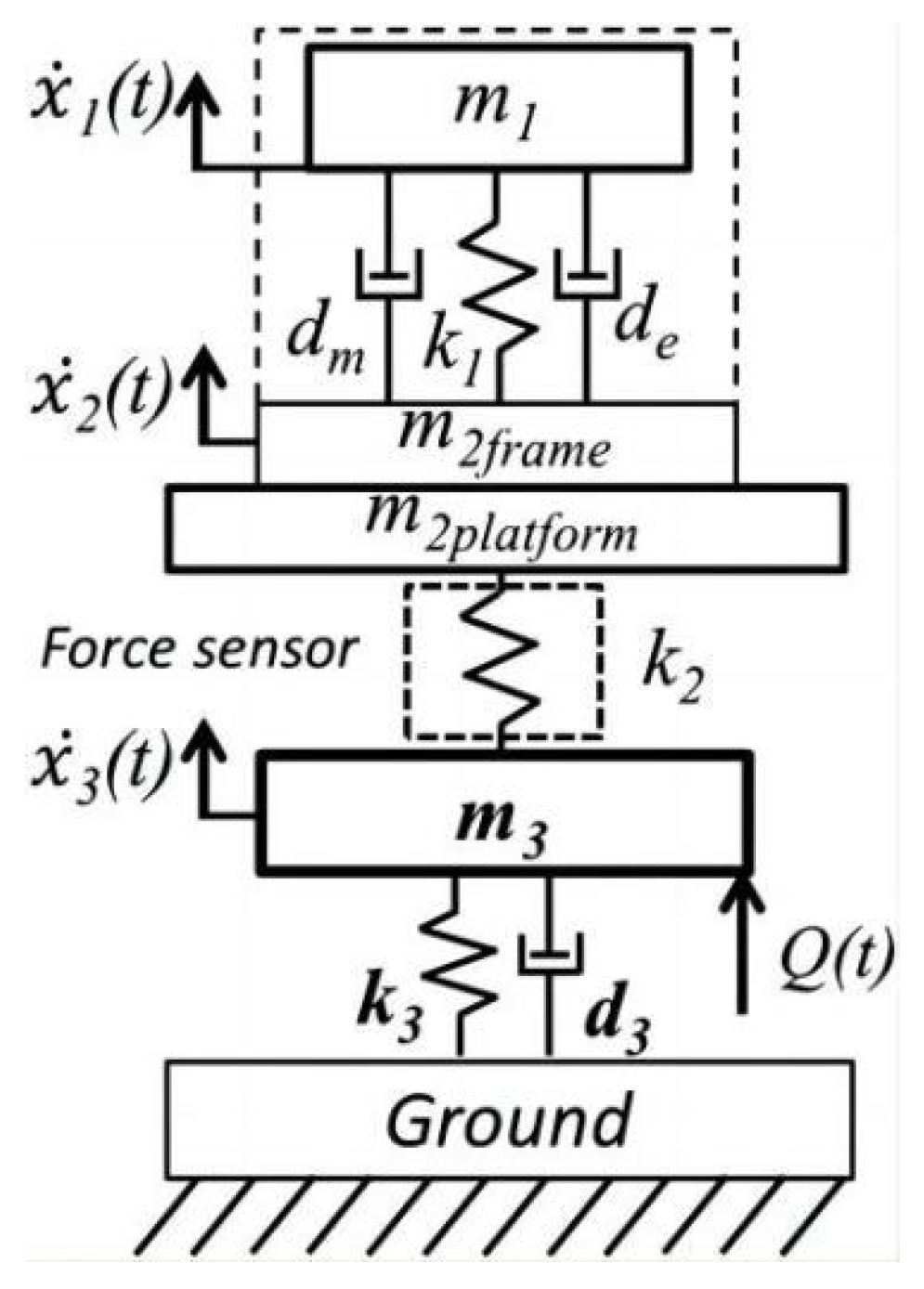
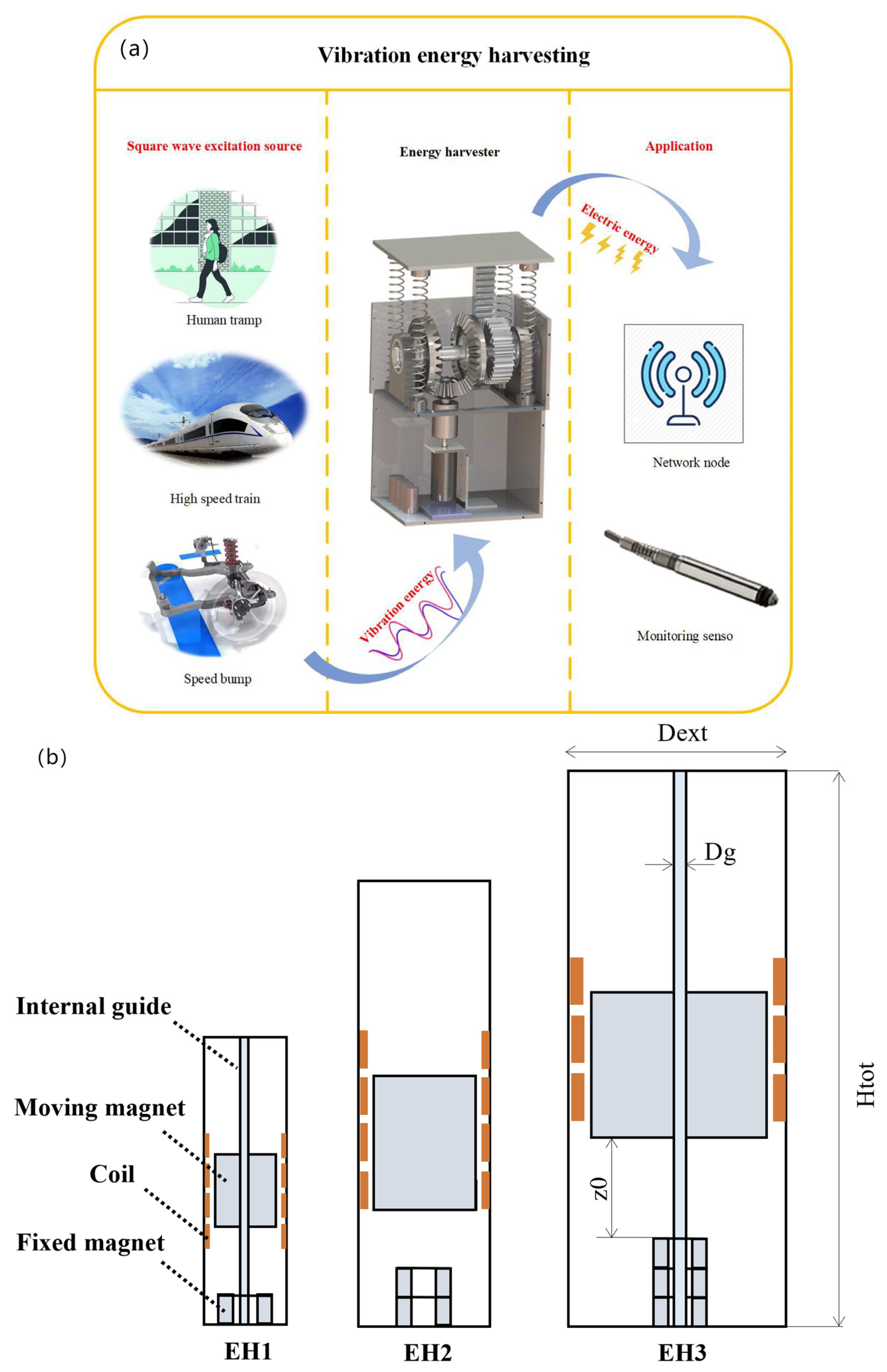
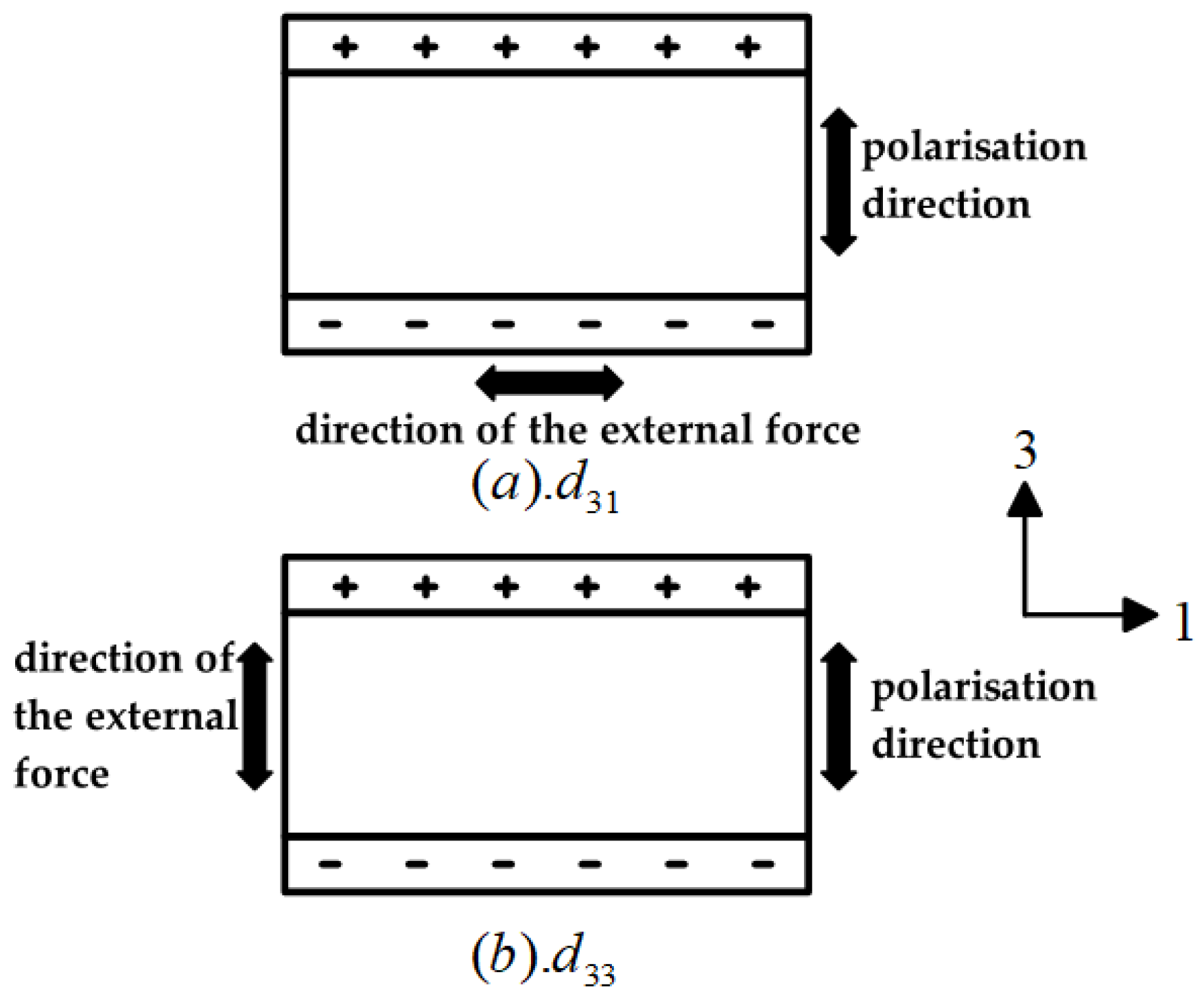

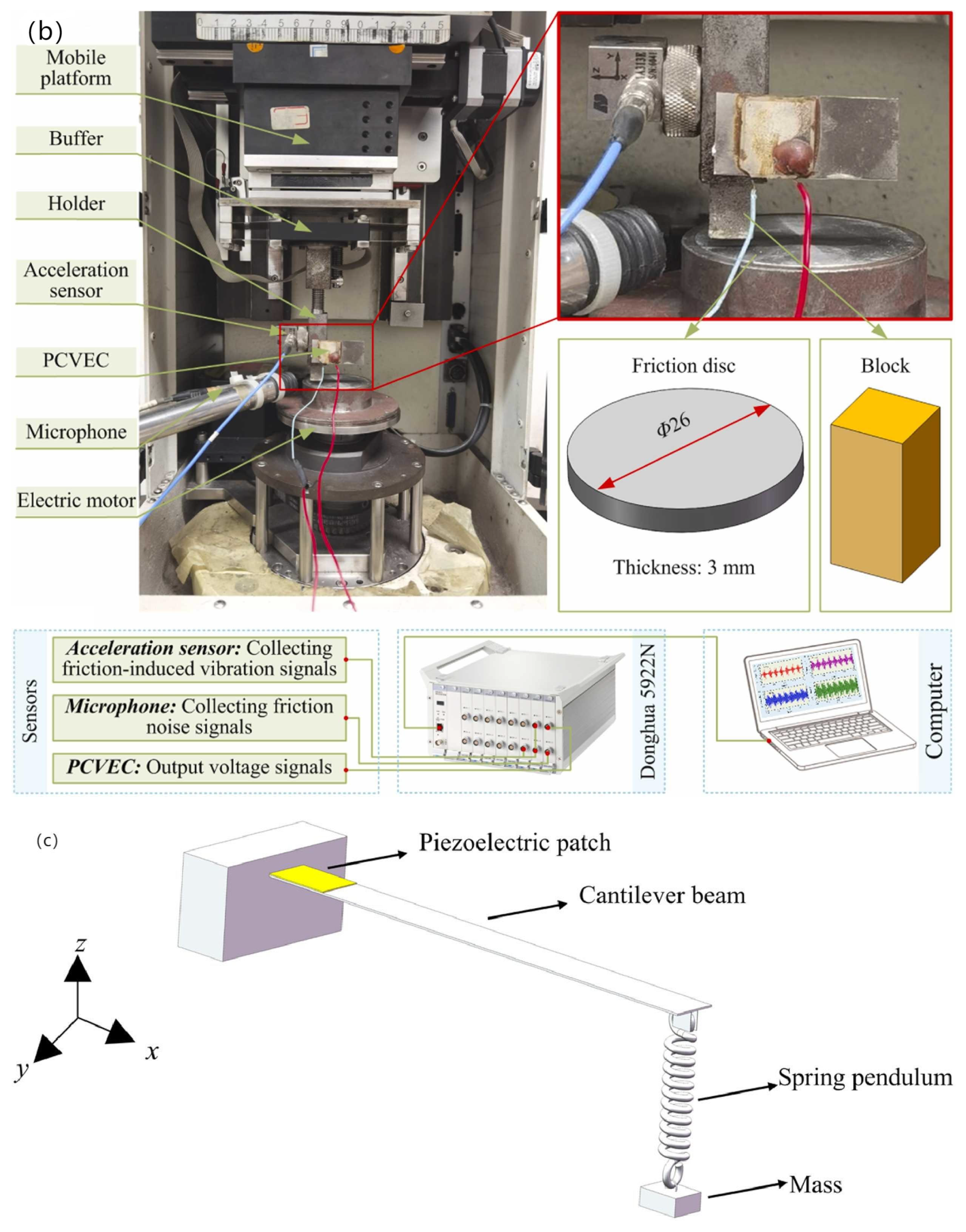

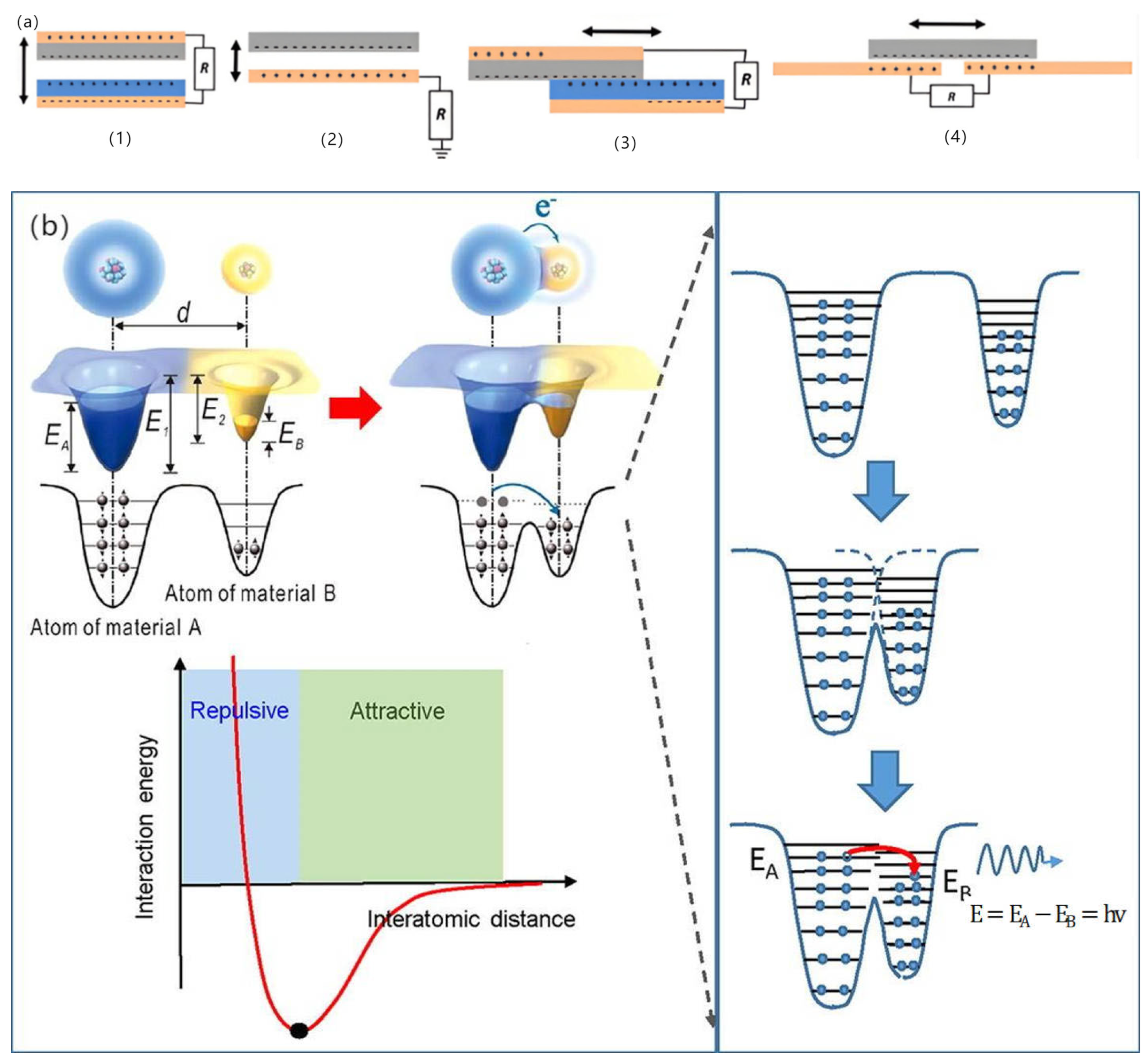
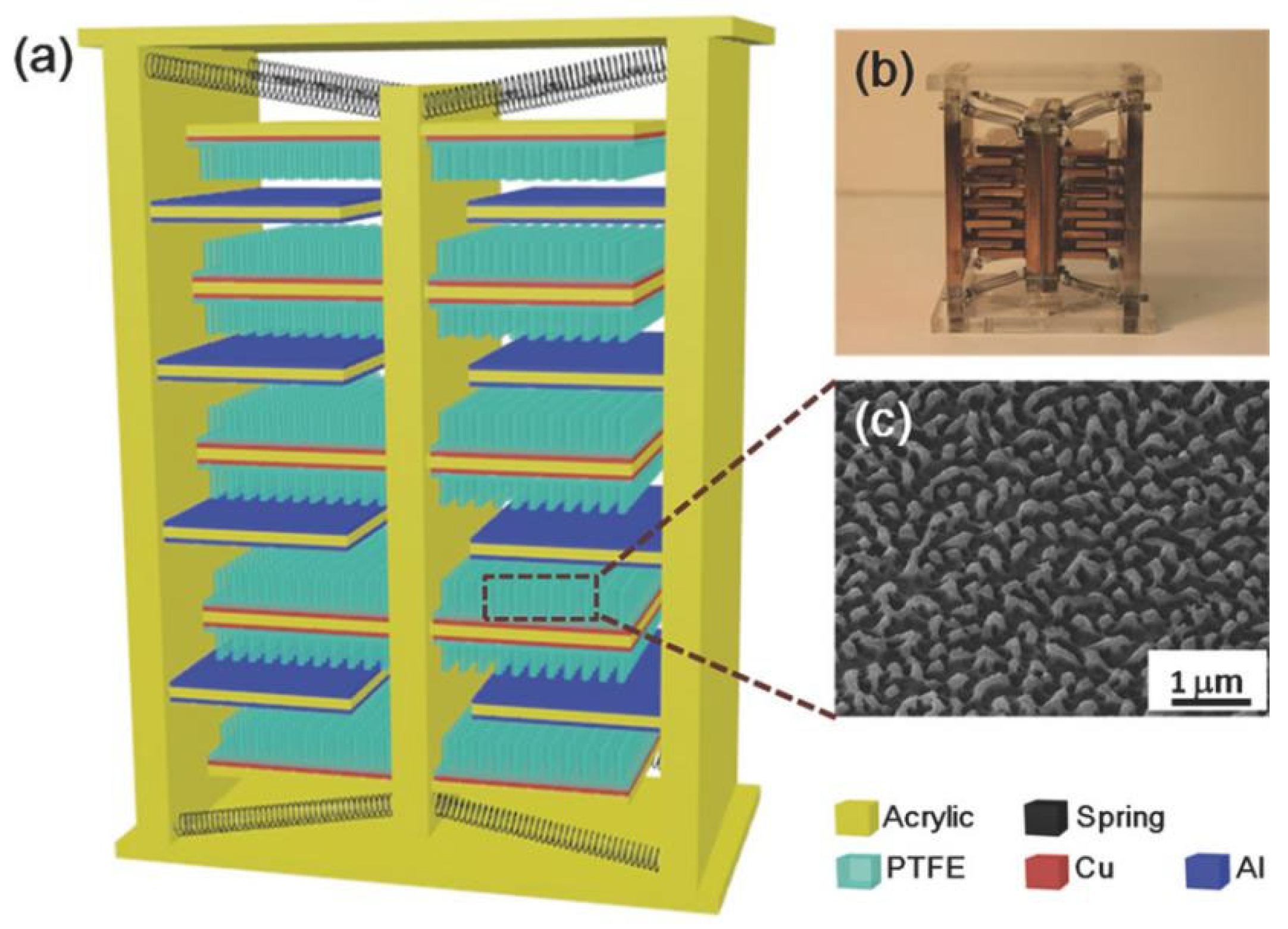
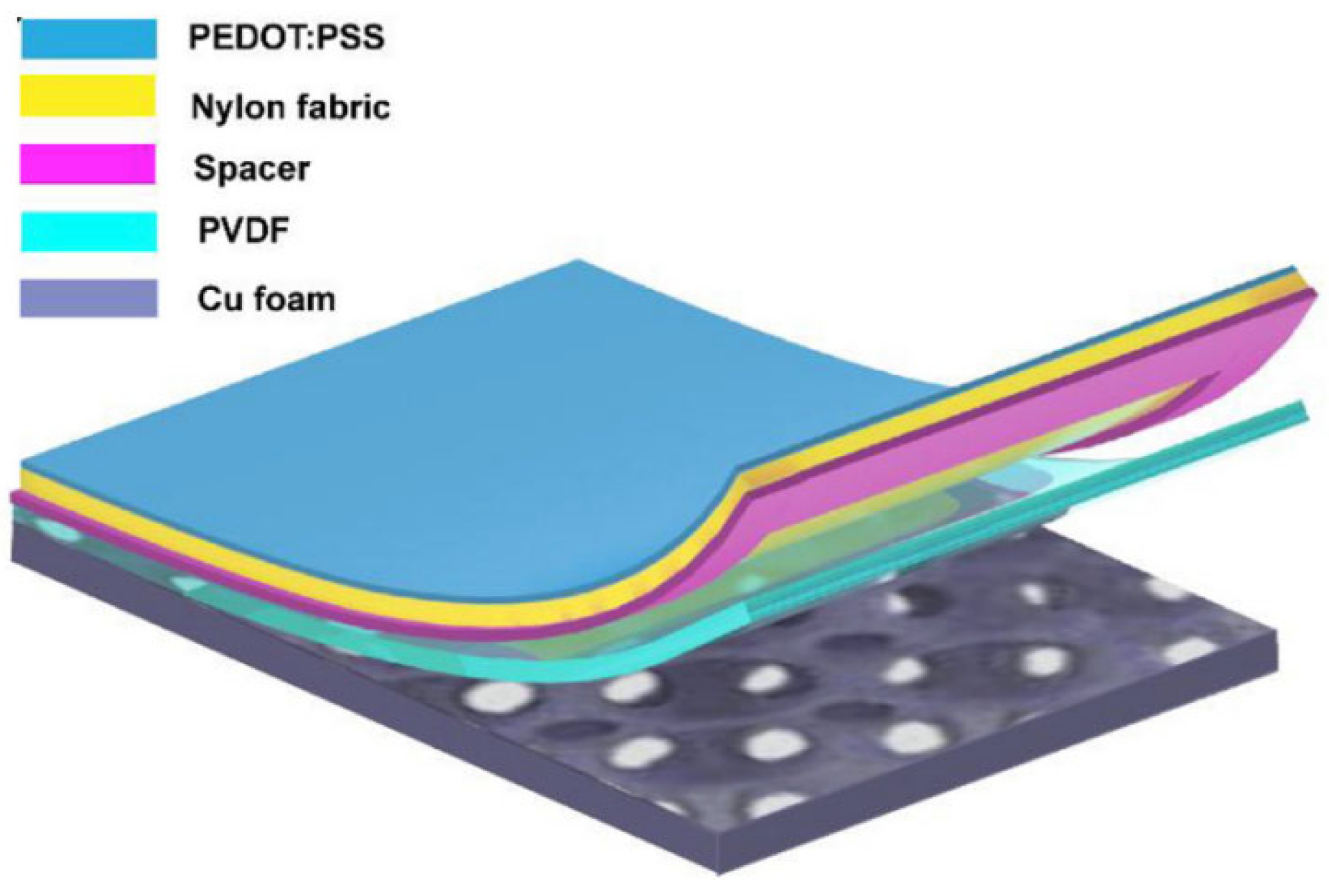

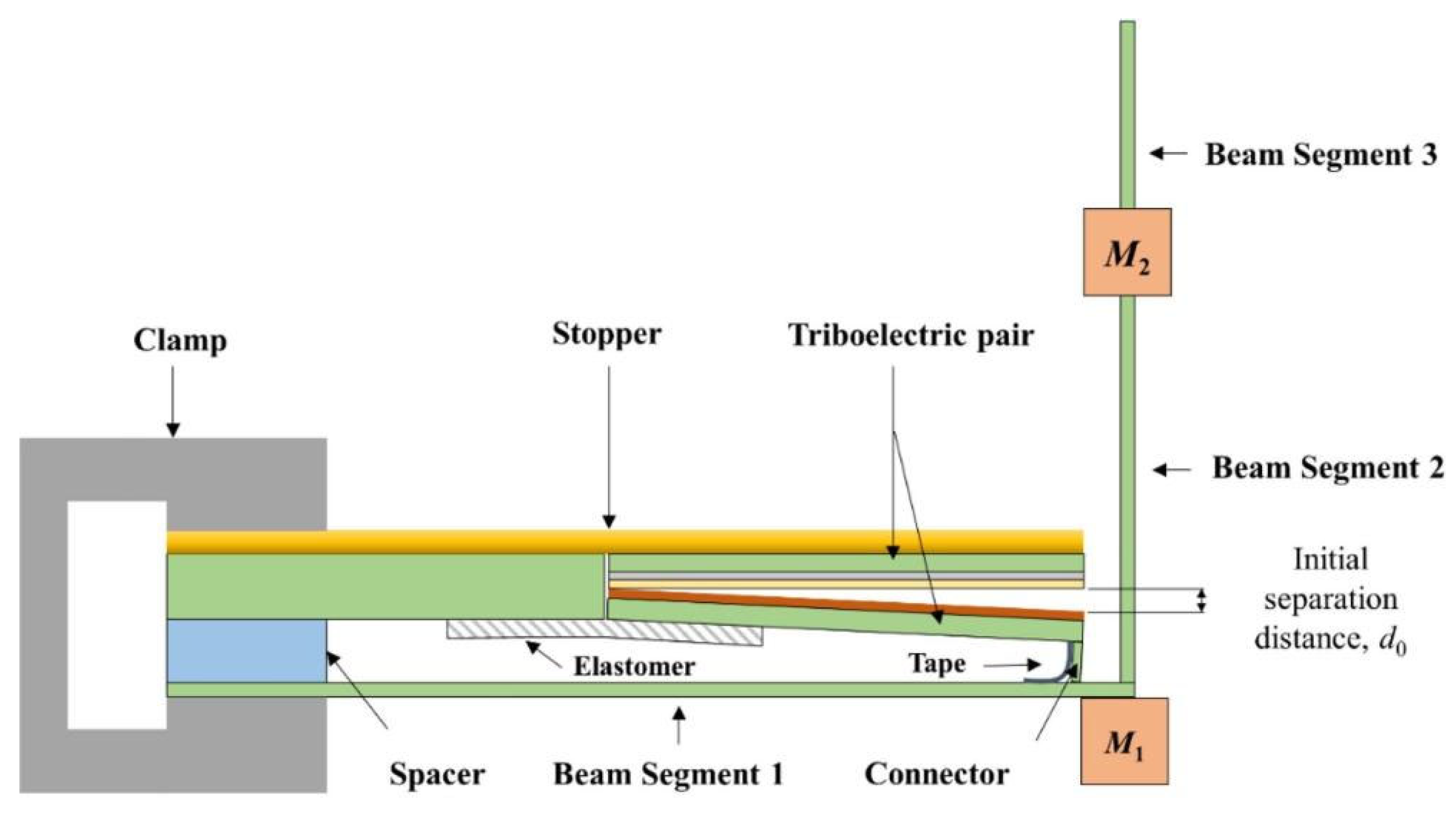
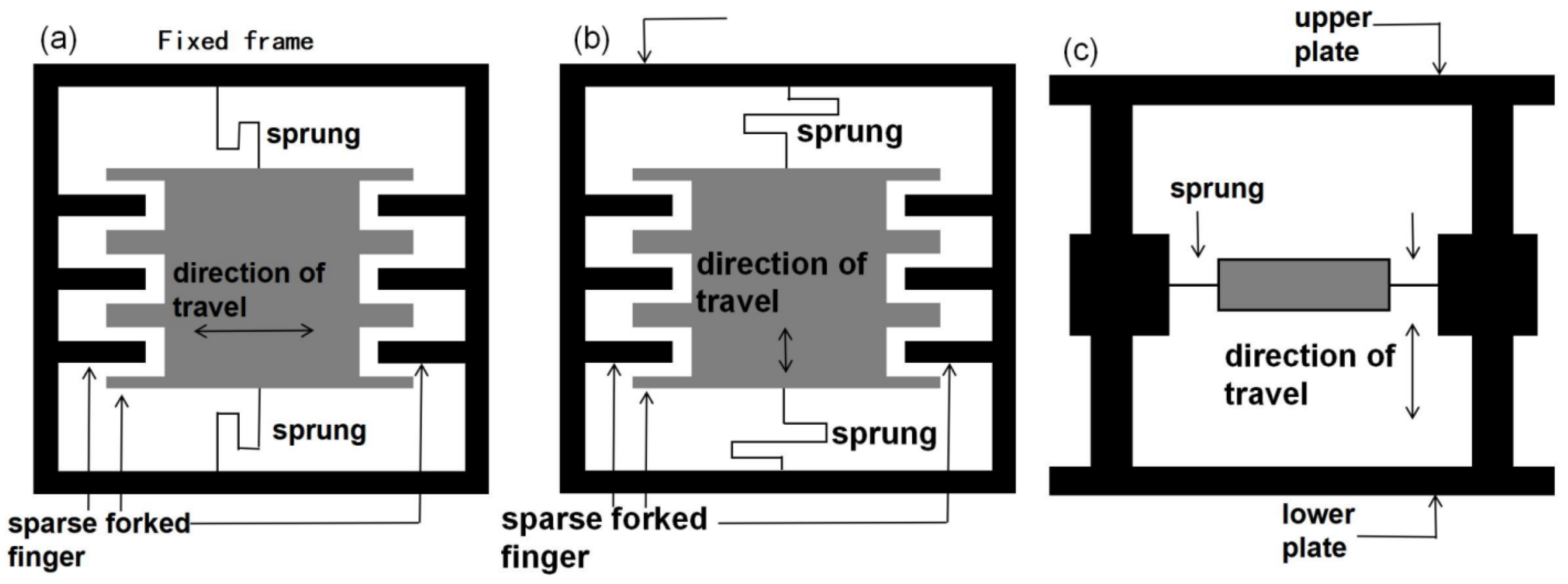
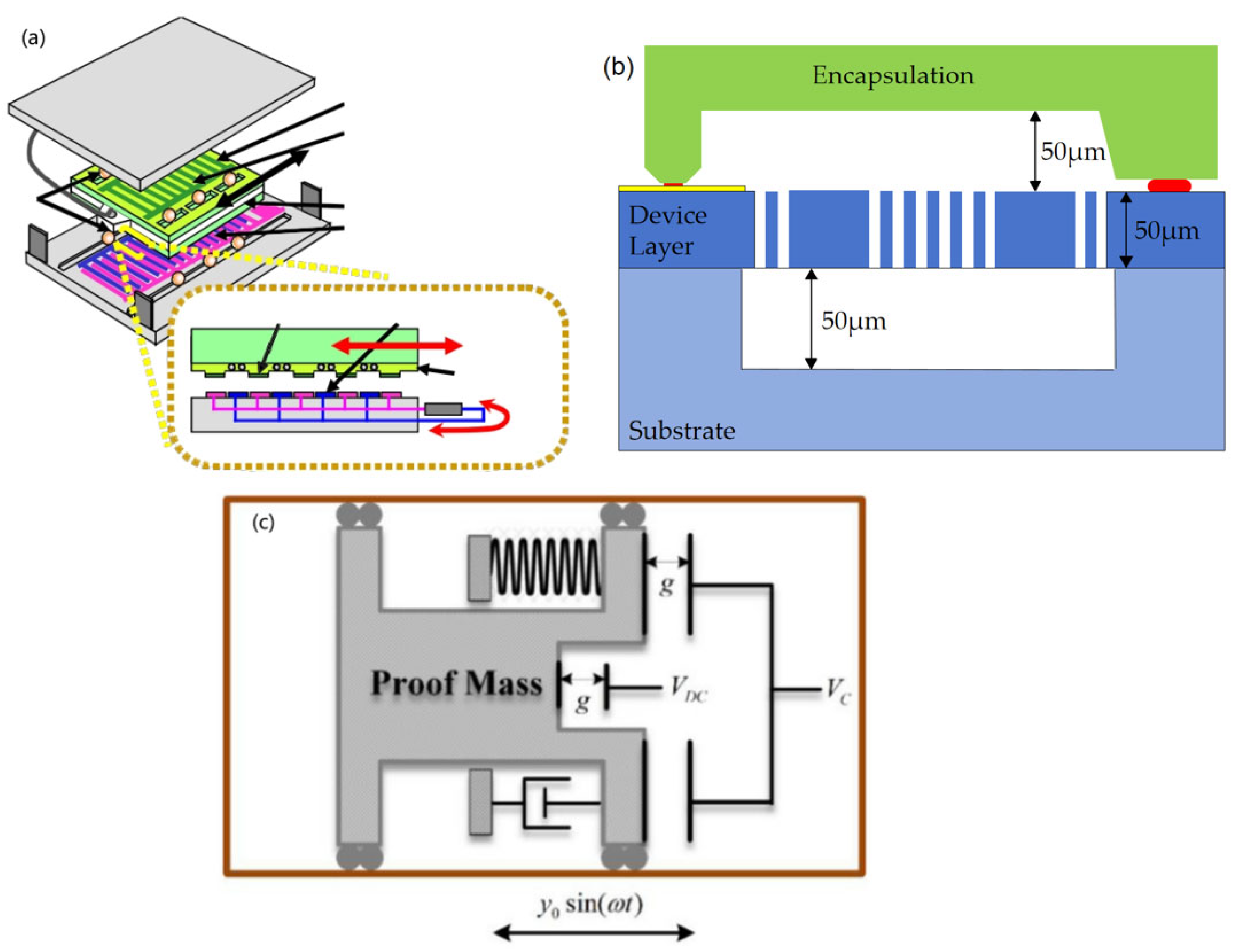
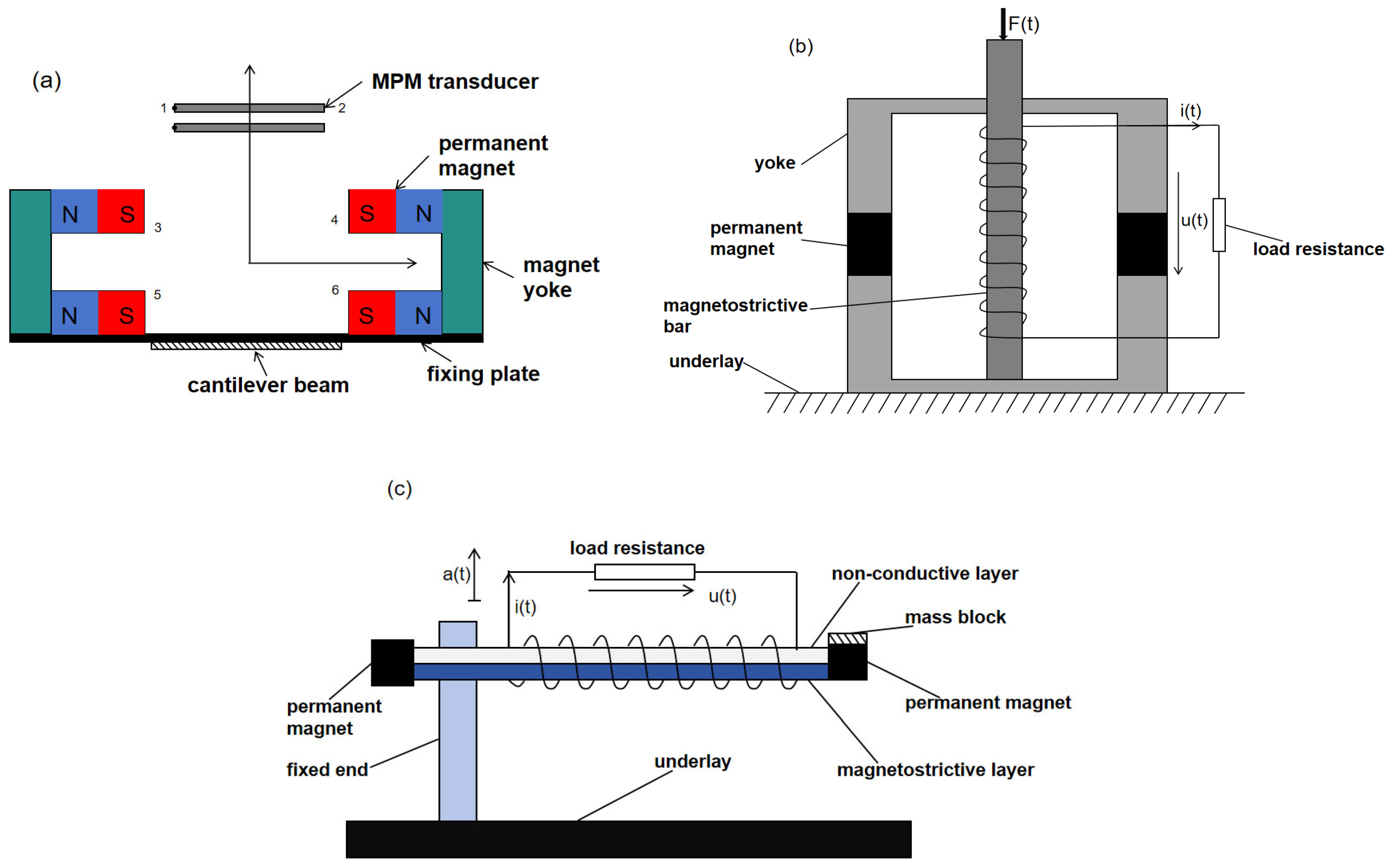

| Authors | Fabric | Frequency (Hz) | Output Voltage/V | Output Power/mW | Power Density/ ) |
|---|---|---|---|---|---|
| Cui et al. [13] | Permanent magnets—coils | 31 | - | 3.83 | - |
| Wang et al. [14] | Rack and pinion, bevel gears | - | 18.5 | 2700 | - |
| Peng et al. [15] | Magnets—coils | 20 | - | 37.45 | - |
| Monaco et al. [16] | magnetic levitation solution | 4 | - | 32 | - |
| Sun et al. [17] | Magnets—coils | 116 | - | 27.2 | 3.6 |
| Lorenzo et al. [18] | Dobby electromagnetic pendulum | 9 | - | 14.4 | - |
| Sun et al. [21] | Spring pendulum | 0.85 | - | 750 | - |
| Piezoelectricity | Electromechanical Coupling Coefficient | Piezoelectric Constant (pC/N) |
|---|---|---|
| AlN | 0.23 | −2.00 |
| CdS | 0.26 | −5.18 |
| ZnO | 0.48 | −5.00 |
| BaTiO3 | 0.49 | −58.0 |
| PZT-4 | 0.70 | −123 |
| PZT-5H | 0.75 | −274 |
| LiNbO3 (lithium niobate) | 0.23 | −1.00 |
| PVDF | 0.19 | 21.0 |
| Authors | Fabric | Frequency (Hz) | Output Voltage/V | Output Power/μW | Power Density/ ) | |
|---|---|---|---|---|---|---|
| Fang et al. [26] | Cantilever beam type | 609 | 0.898 | 21.4 | 2.16 | - |
| Shen et al. [27] | Cantilever beam type | 461.15 | 0.16 | 6 | 2.15 | 3.272 |
| Ye et al. [28] | PSN-PZT piezoelectric ceramics | 10 | 52.89 | - | 35,010 | - |
| Wang et al. [31] | tapered beam | 10.06 | 19.82 | - | - | - |
| Cho et al. [33] | Cantilever beam type | 30 | - | - | 52,500 | 28.48 |
| Lee et al. [34] | Cantilever beam type | 255.9 | 1.792 | 150 | 2.765 | - |
| Remya et al. [35] | Spring-mass block | 30 | 38 | 2700 | - | - |
| Ramírez et al. [36] | Cantilever beam type | 7.91 | 9.8 | 1000 | 96.04 | - |
| Authors | Fabric | Frequency (Hz) | Output Voltage/V | Short-Circuit Current/ | Output Power/mW | Power Density/ ) | Current Density/ (mA-m−2) | |
|---|---|---|---|---|---|---|---|---|
| Yang et al. [41] | Three-dimensional (3D) integrated multilayer TENGs | - | 303 | - | - | 0.6 | 104.6 | - |
| Qiu et al. [42] | Sandwich-shaped acoustic drive TENG | 125 | 546.3 | - | 60.9 | - | - | 25.01 |
| Shi et al. [43] | circular honeycomb | 37 | 50 | - | 3.3 | - | - | - |
| Liu et al. [44] | L-shaped beam | - | 11.56 | 85 | - | 0.3 | - | - |
| Yang et al. [45] | Magnetic fluids | 7 | 0.6 | 90 | 0.00457 | 0.0054 | - | - |
| Gao et al. [46] | Suspension Structure | 13.6 | 30.5 | 1026.6 | 8.2 | - | - | |
| Zhao et al. [47] | Rejection magnet | 2 | 9.7 | - | - | 0.0086 | - | - |
| Authors | Fabric | Frequency (Hz) | Acceleration/(m/s−2) | Load/MΩ | Starting Voltage/V | Output Voltage/V | Output Power/ |
|---|---|---|---|---|---|---|---|
| Naruse et al. [48] | Stripe mask electret | 2 | - | - | - | - | 40 |
| Bu et al. [49] | Block electrodes | 10 | - | - | −700 | - | 5.5 |
| Kloub et al. [50] | Area overlap | - | 1 g | - | 25 | 5.7 | - |
| Tao et al. [51] | Sandwich construction | 122.1 | 5 | - | - | - | 0.22 |
| Ugur et al. [53] | Electret—variable area | - | - | - | - | 300 | 15 |
| Daisuke et al. [54] | Double electret electret | 155 | 1 g | 1 | - | - | - |
| Authors | Fabric | Frequency (Hz) | Output Voltage/mV | Output Power/ | Power Density/ (mW-cm−3) |
|---|---|---|---|---|---|
| Shota et al. [58] | Parallel beam construction | 202 | - | 0.73 | - |
| Dong et al. [60] | Cantilever | - | 780 | 4.35 | - |
| Liu et al. [62] | Galfenol rods—excitation coils | - | 2.64 | 170 | - |
| Liu et al. [63] | Double-stage lozenge | 30 | 250 | 1.056 | - |
| Ueno et al. [64] | Cantilever | 212 | 3000 | 1.2 | 3 |
| Carmine et al. [65] | Three Galfenol rods—permanent magnets | 100 | 6 | 7 |
Disclaimer/Publisher’s Note: The statements, opinions and data contained in all publications are solely those of the individual author(s) and contributor(s) and not of MDPI and/or the editor(s). MDPI and/or the editor(s) disclaim responsibility for any injury to people or property resulting from any ideas, methods, instructions or products referred to in the content. |
© 2024 by the authors. Licensee MDPI, Basel, Switzerland. This article is an open access article distributed under the terms and conditions of the Creative Commons Attribution (CC BY) license (https://creativecommons.org/licenses/by/4.0/).
Share and Cite
Qu, G.; Xia, H.; Liang, Q.; Liu, Y.; Ming, S.; Zhao, J.; Xia, Y.; Wu, J. Current Research Status and Future Trends of Vibration Energy Harvesters. Micromachines 2024, 15, 1109. https://doi.org/10.3390/mi15091109
Qu G, Xia H, Liang Q, Liu Y, Ming S, Zhao J, Xia Y, Wu J. Current Research Status and Future Trends of Vibration Energy Harvesters. Micromachines. 2024; 15(9):1109. https://doi.org/10.3390/mi15091109
Chicago/Turabian StyleQu, Guohao, Hui Xia, Quanwei Liang, Yunping Liu, Shilin Ming, Junke Zhao, Yushu Xia, and Jianbo Wu. 2024. "Current Research Status and Future Trends of Vibration Energy Harvesters" Micromachines 15, no. 9: 1109. https://doi.org/10.3390/mi15091109






